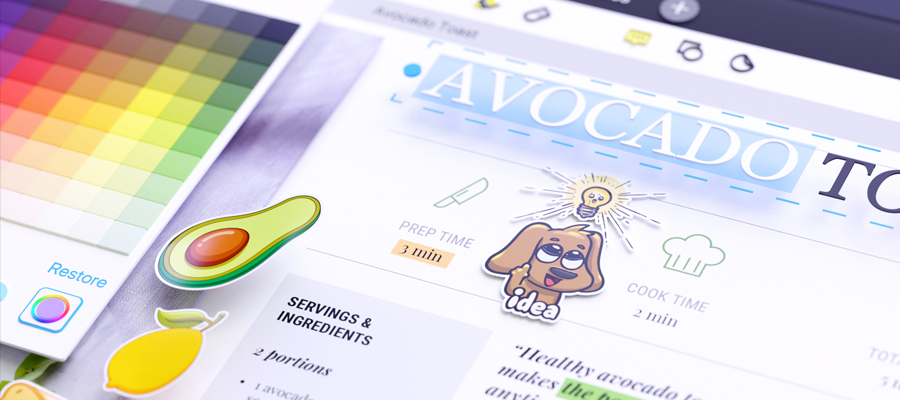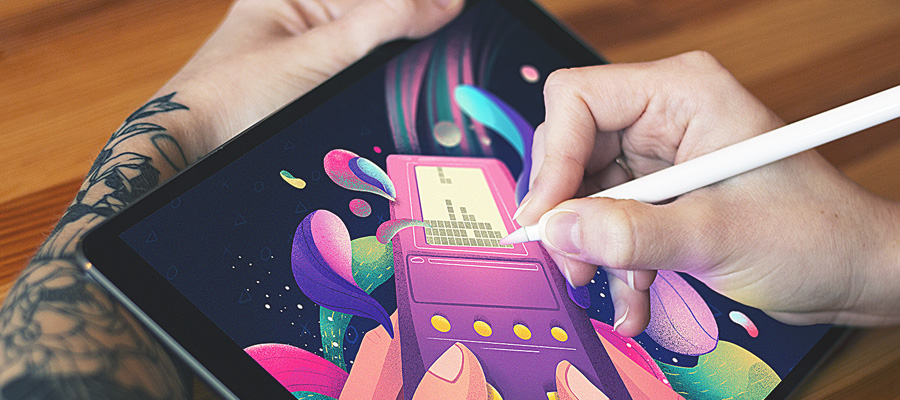If you’re an artist and are trying to get your name out there, building a good portfolio should play a central part in your strategy. In this day and age, getting your work in front of as many eyes as possible has never been easier. However, a lot of artists are still unfamiliar on what actually makes a good portfolio site and how to make theirs more efficient. In this article, we’re going to give you a few simple tips that will make your portfolio much more attractive to visitors and increase the chances of your work getting noticed.

Portfolio Update by Ricky Linn
Make Sure You Start with Your Own Domain
Free domain names and blogging site URLs won’t cut it if you want to project professionalism and for people to take you and your art seriously. There are absolutely no excuses not to have your own domain. If you’ve never bought a domain name before, you might be intimidated by the whole process, but you can register your own domain in nothing but a few minutes and for under $10 in most cases. If you’re looking for a place where you can get a cheap domain name, NameCheap is a good place to start.
You also have to make sure that you pick the right domain name as well. Ideally, you would want to use your first name as a domain, but there are some cases where it’s simply not possible because the name was already taken. You could choose an alternative extension, but I would advise against it. URLs with alternative extensions are just much harder to memorize and don’t stick as much. The best way to get around the name issue is to add descriptive words at the end. For example, if your name was Darren Wilson, then DarrenWilsonArtist.com or DarrenWilsonPainter.com could also work. As long as it’s descriptive, easy to remember and not too clunky, it should make for a good domain name.
Beware of Free Hosting Sites as Well
You should also think twice about using free hosting services. While we understand that you might be strapped for cash at the moment, free hosting sites are almost never a good option. They usually bombard your visitors with unattractive banner ads that can completely take away from their experience. That’s really a bad look for a site whose main goal is to be visually pleasing. So instead, shell out a few bucks for an affordable shared hosting plan as an alternative.

Designer Profiles by Ben Schade
Make Sure Your Site Looks Good on all Platforms and Browsers
You have to be able to give your visitors a uniform experience whether they’re accessing your website from Chrome, Firefox or Internet Explorer. Every browser has their own protocols and one site might look completely different on one browser than the other.
You also have to make sure that your site is responsive and works on mobile platforms as well. Not only will it allow you to reach a wider audience and improve their user experience, but it will also help you from an SEO standpoint. Google privileges sites that are responsive and with low bounce rates as well. Having a responsive website addresses both issues.
If you’re building your own site, then doing this might be a challenge. The only solution here would be to go with an online portfolio platform that will allow you to create a professional looking art portfolio website that looks great on all platforms. These platforms will usually have a wide variety of responsive and attractive themes you can choose from and some are even specialized in artist portfolios. Going with a service like this will really facilitate the design process and will allow you to have a great looking professional artist site in the fraction of the time and budget you’d normally have to set aside for a designer.
Make Sure You Link Your Site to Your Social Media Pages
You should also make sure that you have as many links coming to and from your website from your social media pages if you want your visitors to navigate freely between both. When posting on social media, try to link back to images to your website. Social media, especially visually driven social media like Pinterest and Instagram, is one of the best ways to gain traffic and get your work noticed, so make sure that you make them a central part of your marketing strategy.
But social media is not only a great way to present your art. It’s also a great way to show your story and showcase your personality as well. Your personality will also play a huge role on how your art is received and perceived, so you should at least try to give your audience a glimpse into who you are. A nice interview can be a great way to introduce yourself to the world while showcasing some of your work.

Portfolio Design by Mousecrafted
Keep it as Simple as Possible
The goal of your site should be to give as much space as possible to your work. You aren’t showing off your website design skills here, but your actual artwork. That’s why so many portfolio sites tend to be stripped down and minimalistic; to leave more room for the work to breathe.
You should also make sure that you keep the navigation as simple as possible. Some sites are just a nightmare to navigate with confusing menus, too many options, dead end pages, and overly complicated galleries.
You want your visitors to be able to get from point A to point B as easily as possible on your website. This means reducing your navigation menu options to no more than 6 or 7 choices. Some of the most important page links you should have include:
- Link to your Portfolio or Gallery
- Your “About the Art” or Artist Statement Page
- An “About the Artist” Page
- A Link to your CV
- Purchasing Information
- Your Contact Info
If you go beyond these, your navigation will become too complicated and might end up affecting your user experience. So, try to keep it as simple as possible and make it as easy for your visitors to see and buy your art.
Add Text Explanations, But Don’t Overdo Them
Adding text explanations for your art pieces is important, but you shouldn’t overwhelm your visitors with too much text either. This may include things like your bio, descriptions on methods you’ve used, your statement, etc. But you don’t want to give visitors your life story either; that’s what your “about the artist” page is for.
Try to keep your descriptions and introductions as short and concise as possible - under 300 words if possible. However, you could get away with more if your art has a strong cognitive component to it. If you want to give more background information about the piece or you as an artist, link to other pages where they can read more instead of taking away from the actual piece.
Building an attention grabbing and professional looking portfolio website takes some work and know-how. But once you get a hang of it, you should be able to build a site that puts your work in the best light and leave a lasting impression with your visitors.




















